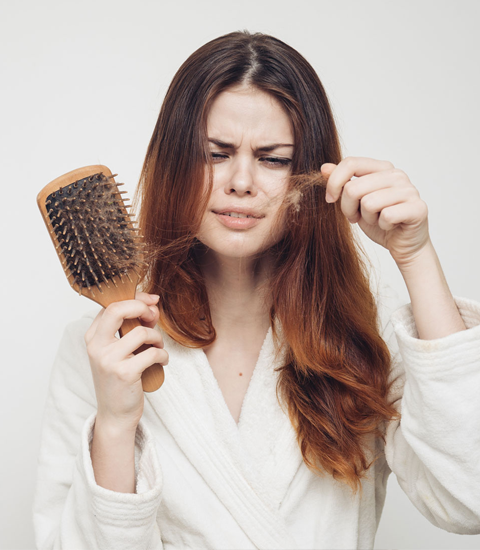Gaining an Understanding of the Causes, Symptoms, and Ways to Prevent Hair Loss
Gaining an Understanding of the Causes, Symptoms, and Ways to Prevent Hair Loss
Alopecia is a disorder that may causes both men and women, and both sexes are equally at risk for developing hair loss. It causes possible for it to affect just the scalp, the whole body, or both, and it may be temporary or permanent. To effectively address this widespread problem, it is vital to have a solid understanding of the reasons that contribute to hair loss, as well as the numerous symptoms and treatment choices.
Why People Lose Their Hair
There are many different things that may play a role in hair loss, including the following:
Hereditary Diseases: As male-pattern baldness, androgenic alopecia, and female-pattern baldness account for the vast majority of cases of hair loss. These diseases often present themselves in recognizable patterns, such as the hairline receding in males and the hairline becoming thinner around the crown in women.
Hormonal Shifts and Medical Conditions: Hormonal shifts that may cause hair loss include those that occur during pregnancy, delivery, menopause, and issues with the thyroid. In addition, disorders such as trichotillomania, a hair-pulling disorder, and alopecia areata, an immune system-related illness that causes patchy hair loss, may be contributors to hair loss.
Drugs and Supplements: There is a possibility that some of the drugs used to treat disorders such as cancer, arthritis, depression, heart issues, gout, and high blood pressure might cause hair loss as a side effect.
Radiation treatment: When radiation treatment is directed towards the head, there is a potential that the hair may not come back as it did before. This is a risk associated with radiation. A substantial mental or physical shock may cause temporary hair loss, which generally becomes visible a few months after the incident that caused the shock.
Traction alopecia is a kind of hair loss that may be caused by excessive hairstyling that pulls the hair firmly, such as pigtails or cornrows. The condition can be treated with certain hairstyles. In addition, some procedures for the hair, such as hot-oil treatments and permanents, may also cause hair to come out, and if scarring occurs, the hair loss can be permanent.
Signs and Symptoms of Thinning Hair
The symptoms of hair loss may vary widely depending on the underlying cause of the condition:
Gradual Thinning: Individuals often experience gradual thinning as they become older, which is the most prevalent kind of hair loss. When males age, their hairlines often recede, but women may observe that the part in their hair becomes more pronounced. A pattern known as frontal fibrosing alopecia, sometimes known as a receding hairline, is becoming more frequent in women as they age.
Patchy on the Scalp: Certain individuals may acquire bald spots that are circular or patchy on the scalp, the beard, or the eyebrows. Before the actual hair loss takes place, these regions could feel uncomfortable or unpleasant.
Sudden Loss of Hair: A sudden loosening of the hair physical or mental trauma might cause a sudden loosening of the hair. This form of hair loss often results in a generalized thinning of the hair however it is normally only transitory.
Loss of Hair Over the Entire Body: Loss of hair over the entire body may be a side effect of some medical illnesses and treatments, such as chemotherapy for cancer. However, in the majority of instances, the hair will eventually come back.
Scaly Patches: Scaling on the scalp, together with damaged hair, redness, swelling, and occasionally leaking, might be an indication of ringworm. Ringworm can also cause other symptoms such as redness and edema.
The Role of Treatment and Prevention
Although it is possible that genetic hair loss cannot be prevented, there are several things that may be done to avoid other forms of hair loss, including the following:
How you treat your hair: When caring for your hair gently, you should brush and comb it without straining or pulling on it in any way, and this is particularly important when your hair is damp. If you want to prevent your hair from breaking, you might think about investing in a detangler and a wide-toothed comb. Avoid utilizing harsh treatments on your hair such as hot rollers, curling irons, hot oil treatments, and permanents as much as possible. In addition, it is important to restrict the use of hairstyles that strain the hair firmly, such as braids, barrettes, and rubber bands.
Examining your drugs and supplements: Speak with your primary care physician if you have any reason to believe that the drugs or supplements you are taking might be causing or contributing to your hair loss so that you can investigate other treatment options.
Sunlight Protection: It is essential to shield your hair from direct sunlight and UV radiation, since prolonged exposure to the sun may cause damage to the hair.
Putting an End to Smoking: Several studies have shown a possible connection between smoking and male pattern baldness. Putting an end to one’s smoking habit may have a number of beneficial impacts on one’s health, including a possible reduction in hair loss.
Using a Cooling Cap: While receiving chemotherapy wearing a cooling cap may lower the likelihood of experiencing hair loss over the course of treatment for patients.
Remember that you should seek the advice of a medical professional in the event that you have chronic hair loss or are worried about abrupt or patchy hair loss in order to identify the underlying reason and explore the many treatment options that are available to you. When treatment begins at an early stage, it generally stops further hair loss and stimulates healthy new hair growth. If you require further information, our qualified physicians will assist you.
You can call us at 9704946534/040-48553939 or visit our website at www.drpraneethclinic.com.

